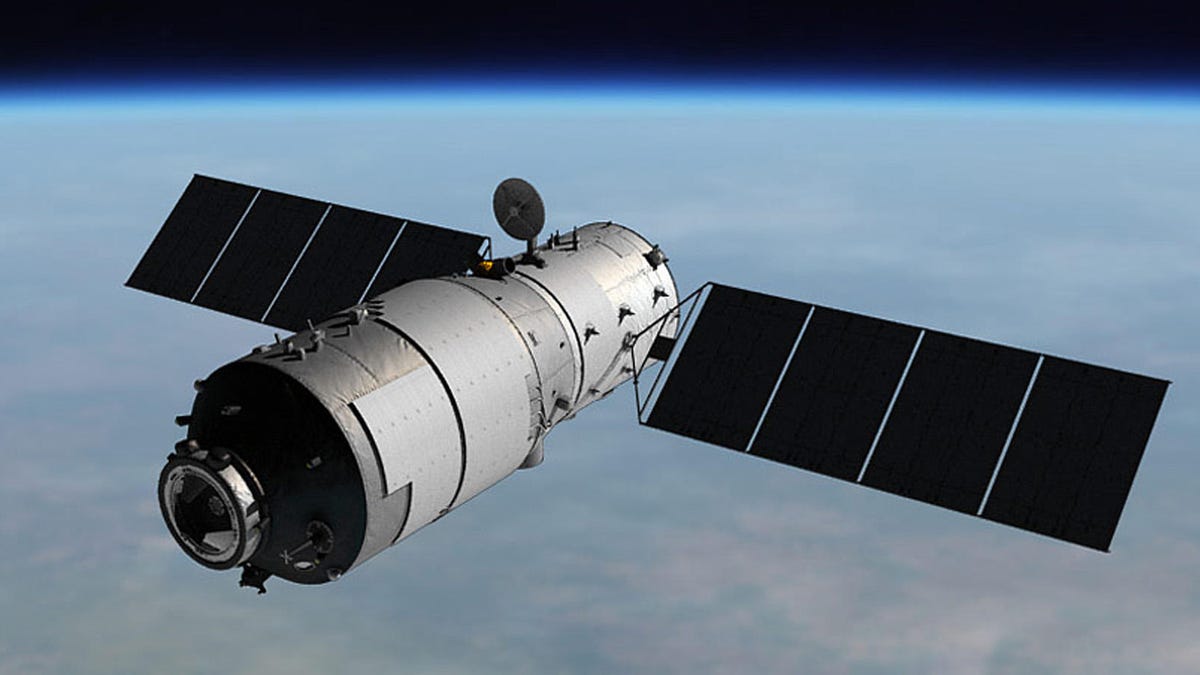China's Tiangong-1 space station will soon fall to Earth
China's first space station launched in 2011 and was supposed to wind up in the Pacific Ocean. Now it's anyone's guess where the thing will land.

An artist's rendition of Tiangong-1 in orbit.
Tiangong-1 is no April Fool's joke.
The out-of-control Chinese space station is now predicted to re-enter the Earth's atmosphere sometime around the beginning of April. Most of it will burn up on the way down, but it's possible some pieces of the 9-ton spacecraft could make it to the surface.
Tiangong means "Heavenly Palace" in English and Tiangong-1 was China's first space station, launched in 2011. The original plan for the craft's demise was a controlled re-entry that would allow it to burn up over an unpopulated section of the South Pacific, with any surviving fragments falling in the sea.
But as early as March 2016, reports began to suggest that Tiangong-1 was malfunctioning and ground crews had lost control of the craft. In other words, there appears to be little chance of performing the maneuvers to steer it to a graceful breakup over the ocean. Instead, it's all up to chance.
According to a new projection from the European Space Agency on Tuesday, the space station is expected to make a likely uncontrolled re-entry roughly between March 29 and April 9. The ESA stresses that it won't be possible to make a precise prediction about exactly when or where Tiangong-1 will burn up and how much of it will get all the way through the atmosphere to the surface.
That said, the Chinese space station is fairly easy to track and ESA says in an online FAQ that we should know about a day in advance of the craft's end which regions of the planet might be able to see it actually burning up in the sky. Predicting where any impact might occur is significantly more difficult, however.
"Even 7 hours before the actual re-entry, the uncertainty on the break-up location is a full orbital revolution -- meaning plus or minus thousands of kilometers," writes ESA's Daniel Scuka.
Tiangong-1's orbit spans from 43 degrees north to 43 degrees south, or from the central United States down to the southern tip of Australia, according to Jay Melosh, a professor of earth, atmospheric and planetary sciences at Purdue University. He explains that it could come down anywhere between the two points but is more likely to land at either extreme because the station spends more time there.
"It's like a pendulum – it spends more time at the limits of its swing than when it's moving fast," Melosh said in a statement last month.
The yellow bands indicate the areas where Tiangong-1 is most likely to re-enter the atmosphere. Green is less likely and blue is unlikely.
As a result, you may have seen some inflammatory headlines saying that the space station is "likely to hit northern US states," but the truth is that it's just as likely to hit anywhere else that's around 43 degrees north or south of the equator, including the Atlantic, Pacific, southern Europe, central Asia, China, New Zealand, Tasmania and a little strip of southern Patagonia. The above map from The Aerospace Corporation, which has also been tracking Tiangong-1's demise, shows those regions in yellow. The spacecraft is a little less likely to re-enter over the green areas and unlikely to come down anywhere in blue.
In other words, who knows?
"In terms of where it will land, a few hours of uncertainty spans a lot of territory," Melosh said. "That could be the difference between landing in Chile and the middle of the Pacific."
The scenario is reminiscent of the semi-controlled re-entry of Skylab in 1979. A hunk of that early space station wound up impacting an unpopulated part of Australia. No one was hurt, but NASA did receive a ticket for a few hundred dollars for littering.
If you want to check on Tiangong-1 from moment to moment, you can use any number of live tracking sites like N2YO. Meanwhile, be sure to keep one eye on the sky in the coming weeks.
Crowd Control: A crowdsourced science fiction novel written by CNET readers.
Solving for XX: The tech industry seeks to overcome outdated ideas about "women in tech."

